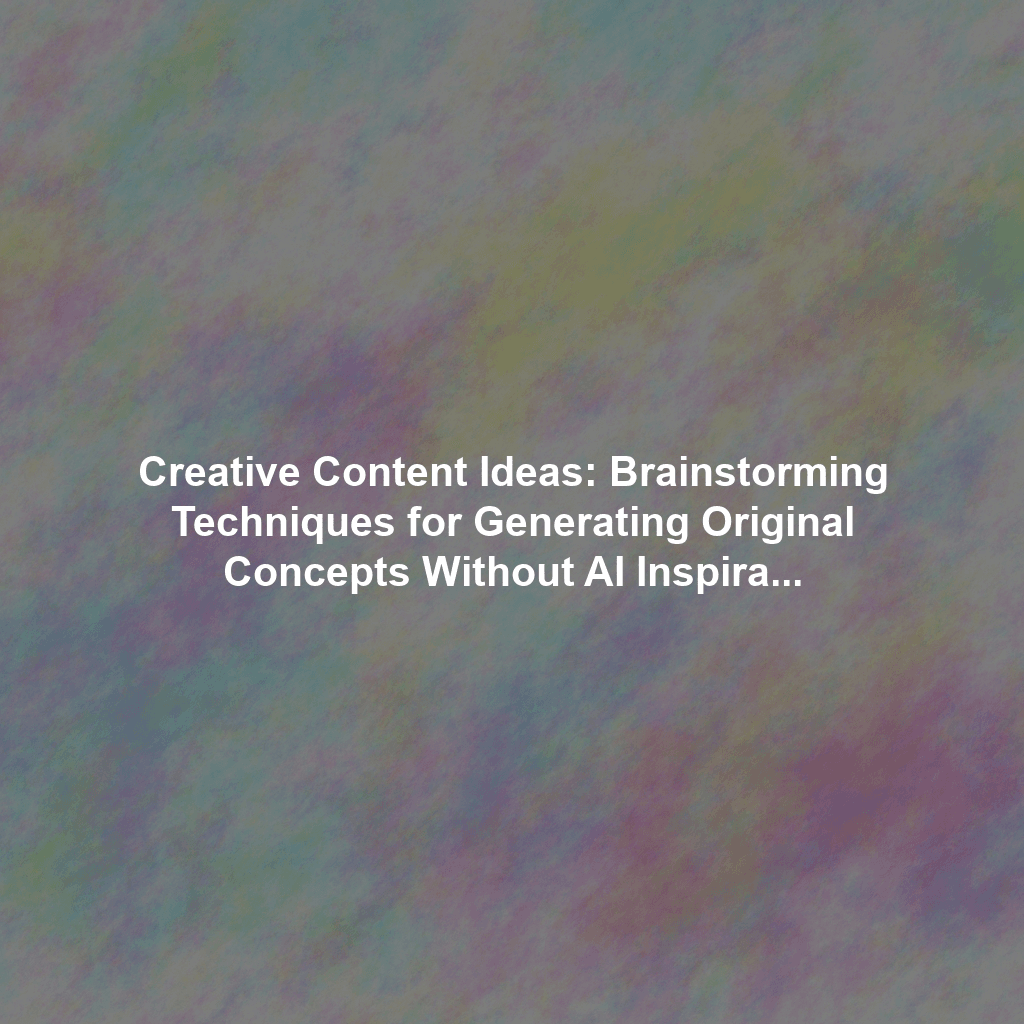In today’s digital landscape, content is king. But creating content that truly resonates with your audience, stands out from the noise, and drives meaningful engagement requires more than just churning out words. It demands originality, insight, and a deep understanding of your target audience. And while AI tools promise to automate content creation, true differentiation comes from the uniquely human ability to think creatively and brainstorm effectively. This article explores proven brainstorming techniques to unlock your team’s creative potential and generate truly original content ideas, all without relying on AI assistance.
Why Human Brainstorming Still Matters
While AI can assist with certain aspects of content creation, it often lacks the nuanced understanding, emotional intelligence, and genuine creative spark that comes from human collaboration. Human brainstorming allows for:
- Unexpected Connections: Brainstorming brings diverse perspectives together, fostering unexpected connections and innovative ideas that AI might miss.
- Emotional Resonance: Humans can better understand and tap into the emotions and motivations of their target audience.
- Ethical Considerations: AI may inadvertently perpetuate biases or generate inappropriate content. Human oversight ensures ethical and responsible content creation.
- True Originality: AI often rehashes existing information. Human brainstorming allows for truly original and groundbreaking ideas.
Powerful Brainstorming Techniques for Content Creation
Here are some tried-and-true brainstorming techniques that can help your team generate fresh and engaging content ideas:
Mind Mapping
Mind mapping is a visual brainstorming technique that starts with a central idea and branches out into related topics, subtopics, and keywords. This method is excellent for exploring connections and uncovering hidden opportunities for content creation.
How to implement it:
- Write your core topic (e.g., “Sustainable Living”) in the center of a large whiteboard or piece of paper.
- Draw branches radiating outwards, representing key areas related to the core topic (e.g., “Eco-Friendly Products,” “Reducing Waste,” “Sustainable Travel”).
- For each key area, add further branches with subtopics and specific content ideas (e.g., under “Eco-Friendly Products”: “Bamboo Toothbrushes,” “Reusable Water Bottles,” “Organic Clothing”).
- Encourage everyone to contribute, no matter how “out there” the idea may seem.
Reverse Brainstorming
Instead of asking “How can we solve this problem?”, reverse brainstorming asks “How can we cause this problem?”. This approach can reveal unexpected insights and lead to innovative solutions by examining potential pitfalls and challenges.
How to implement it:
- Define a problem you’re trying to solve with your content (e.g., “Lack of engagement on our social media posts”).
- Ask the team: “How could we make our social media posts even *less* engaging?”.
- List all the ways you could make the problem worse (e.g., “Post irrelevant content,” “Use clickbait headlines,” “Ignore comments”).
- Now, reverse these ideas to find potential solutions (e.g., “Post highly relevant content,” “Use clear and honest headlines,” “Actively engage with comments”).
SCAMPER
SCAMPER is an acronym that stands for: Substitute, Combine, Adapt, Modify, Put to other uses, Eliminate, Reverse. This checklist provides a framework for generating new ideas by prompting you to think about existing content in different ways.
How to implement it:
- Choose an existing piece of content or a content idea.
- Run through the SCAMPER checklist, asking questions like:
- Substitute: What could we substitute in this content? (e.g., a different visual, a new statistic, a guest speaker)
- Combine: What could we combine this content with? (e.g., another blog post, a podcast episode, an infographic)
- Adapt: What could we adapt this content to? (e.g., a different platform, a different audience, a different format)
- Modify: What could we modify about this content? (e.g., its tone, its length, its level of detail)
- Put to other uses: What other uses could this content have? (e.g., a training resource, a sales presentation, a lead magnet)
- Eliminate: What could we eliminate from this content? (e.g., unnecessary jargon, redundant information, distracting visuals)
- Reverse: What could we reverse about this content? (e.g., its perspective, its order, its conclusion)
- Document all the ideas generated during this process.
Creating a Brainstorming-Friendly Environment
The success of any brainstorming session depends on creating a supportive and encouraging environment. Here are some tips:
- Encourage participation: Make sure everyone feels comfortable sharing their ideas, no matter how unconventional.
- Defer judgment: Avoid criticizing or dismissing ideas during the brainstorming phase. The goal is to generate as many ideas as possible.
- Set a clear goal: Define the specific objective of the brainstorming session to keep everyone focused.
- Provide inspiration: Share examples of successful content from other sources to spark creativity.
- Time-box the session: Set a time limit to maintain focus and momentum.
From Brainstorming to Actionable Content Plans
Once you’ve generated a wealth of content ideas, it’s time to translate them into actionable plans. Here’s how:
- Prioritize ideas: Evaluate each idea based on its potential impact, relevance, and feasibility.
- Develop content calendars: Plan out your content schedule, assigning topics, deadlines, and responsibilities.
- Create content briefs: Provide writers with clear instructions and guidelines for each piece of content.
- Track results: Monitor the performance of your content and make adjustments as needed.
Overcoming Creative Blocks
Even with the best brainstorming techniques, creative blocks can happen. Here are some strategies to overcome them:
- Take a break: Stepping away from the problem can often provide a fresh perspective.
- Change your environment: Working in a different location can stimulate new ideas.
- Seek inspiration: Read books, watch movies, or explore other sources of inspiration.
- Talk to someone: Discussing your challenges with a colleague or mentor can help you break through creative barriers.
Conclusion
In a world increasingly dominated by AI, the ability to think creatively and brainstorm effectively remains a crucial skill for marketers. By embracing collaborative brainstorming techniques like mind mapping, reverse brainstorming, and SCAMPER, you can unlock your team’s creative potential and generate truly original content ideas that resonate with your audience, build your brand, and drive meaningful results. So ditch the AI dependence and harness the power of human ingenuity to create content that truly stands out.
 Skip to content
Skip to content

